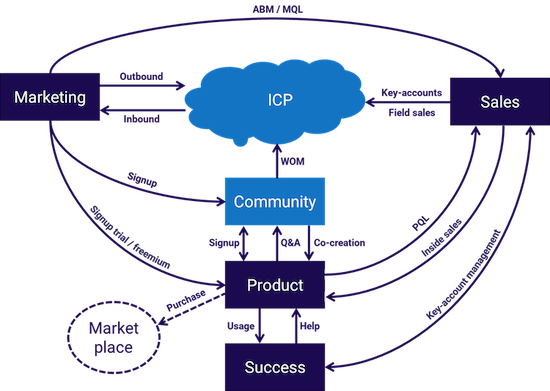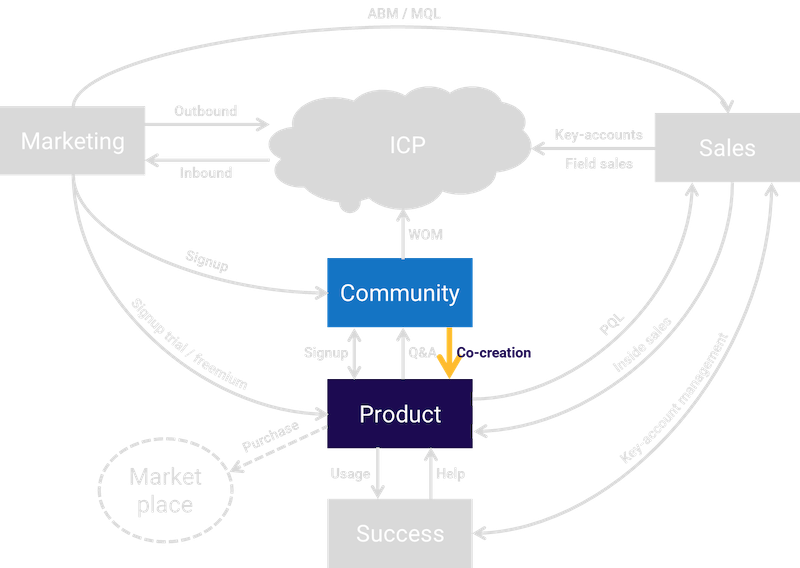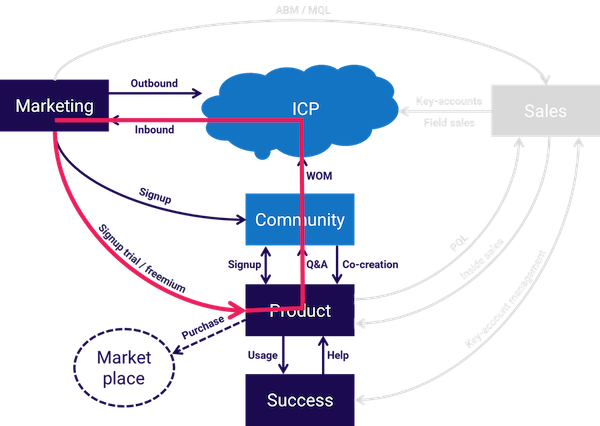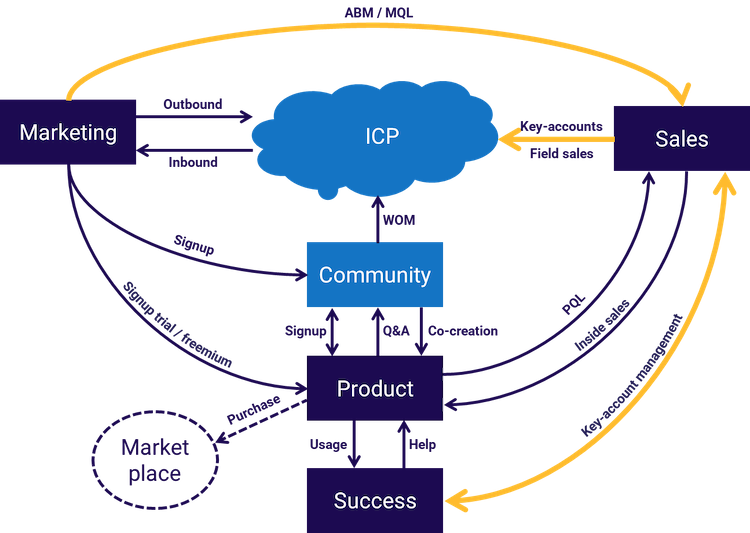The phenomenal success of hyper-growth companies like Slack, Dropbox, Atlassian, Datadog, and Snowflake has triggered many discussions about modern go-to-market (GTM) methods for B2B SaaS, including PLG, PLS, community-led, ABM, marketplace, and others.

But how are all these modern methods related, and even more importantly, how and when should they be combined? This post aims to put the main methods into one framework to create an actionable modern GTM playbook for B2B SaaS start-ups.
The playbook is applicable to most business software categories, including those with complex data input, process integration, or configuration challenges, assuming that these products leverage the latest techniques like a modern data stack, modern iPaaS, or no-code/low code.
The playbook proposes five phases to systematically build a new B2B business from zero revenue to high annual recurring revenue (ARR) growth.
Phase 1: Find the PMF
The objective of the first phase is to build a community of co-creators who help you to find your product-market-fit (PMF).

The actions are as follows:
Build a community of co-creators
Collaborate with users and partners who struggle with the problem you solve and would love to use your product if it existed. Ensure that the community represents your ideal customer profile (ICP) and that members are active contributors.
Avoid confirmation bias, by actively looking for feedback that disproves your point of view. Use an “invitation only” approach and appoint a community manager at this early stage in your GTM journey to facilitate the engagement. When targeting developers, community building can encompass open-source software (OSS) development.

Find product-market-fit
Explore use cases, product designs, and pricing with the community. Build the minimum viable product (MVP) and iterate with your members.
Once the initial community is happy with the MVP, use founder selling to win 10–20 new paying customers outside the community. This will prove your message fit and confirm your understanding of the required manual onboarding and purchasing process.
Phase 1 is achieved when you have found your PMF and your first users have become fans. Run a survey to ask users how disappointed they would be if the product did not exist. If 40% are very disappointed you have achieved PMF. At this point, you will have generated your first ARR.
Don’t hire a VP sales or field sales team now – wait until phase three. If you hire sales too early, you’ll gain the benefits of short-term revenue but lose your chance to build a modern, high-growth engine. The sales team will carry you in many different directions, distracting focus from phase two.
Phase 2: Build a PLG flywheel
Phases two to five focus on developing the go-to-market fit (GTM-fit) and building the growth engine. The objective of phase two is to build a product-led-growth (PLG) flywheel – the backbone of your growth engine.
A flywheel is, in contrast to a funnel, a self-amplifying system. In traditional sales-led growth models, marketing and sales investments are proportional to the resulting sales funnel. More marketing investments create more leads, so more field sales reps are needed to execute these leads. It’s an expensive, linear model.
In contrast, the flywheel is a recursive model that amplifies itself after an initial investment, with lower ongoing product and marketing activities.
Your community users will refer your product to peers, who sign up on your website and onboard themselves, all without any human intervention from your team. After using the software, some become advocates who recommend you to their peers.
Product-related network effects are also important and can be achieved by adding collaboration features. This is the type of word-of-mouth (WOM) and in-product network effect we want to create in phase two.

In phase two, the actions are as follows:
Build self-serve user onboarding
Focus your product development on programming the entire onboarding process into the product without a human in the loop.
Here, your goal is to deliver quick time-to-value to keep your users motivated to continue testing and using your product. Use product analytics tools and work closely with your community to make onboarding more and more frictionless.
Implement freemium or free trial
Implementing a freemium or a free trial is a great way to convert active test users into paying customers. Users should be able to purchase your solution with their credit card inside your product or at a cloud marketplace.
Cloud marketplaces like AWS and Google offer great incentives by counting dollars spent on your product toward the customer’s annual spending commitment to get a lower rate.
Add collaboration features
When someone who’s using your product invites a colleague (who is not a user) to collaborate with them inside it, you gain the strongest possible endorsement and referral.
This is a fantastic way to market your product and a great way to generate network effects. Witness the collaboration capabilities used by Slack or Zoom to encourage existing users to invite new users to the product, who in turn invite more new users.
Add referral features
Even if you have the world’s greatest product, it might not attract a ton of product reviews. This speaks to the importance of building prompts into your product to encourage users to post reviews elsewhere. For example, when someone gives you an outstanding Net Promoter Score (9 or 10), provide a link and encouragement to leave a review on G2 or your website.

Build a brand
Here are some tips to help you build a successful brand:
- Remember: your goal is to attract potential customers to your website and convert them to the freemium or free trial with a consistent and outstanding user experience.
- Position your brand either to disrupt a practice or champion a role.
- Design an engaging brand identity that’s codified and consistently presented at all touch points.
- Make sure your name is easy to remember, say out loud, and write down. This will make it much easier for users to refer you to friends and colleagues.
- Outbound and inbound marketing should leverage thought leadership with community contributions, as well as benchmark metrics for compelling content.
- Forget the standard search engine optimization (SEO) playbook based on the most popular keywords to drive traffic. Build your SEO architecture around your product USP and real human questions to drive sales.
Establish a success team
It will take time to fully automate the onboarding, renewal, and expansion process. Start with people who handhold users to help them fill process gaps. Over time, and with more automation, your success team will be able to use product analytics data to proactively help users engage and extend successfully, so your team expands to support more accounts at higher quality with less staff.
Don’t hire people with an issue-to-resolution mindset, hire people with an issue-to-retention mindset to drive the net retention rate (NRR).
Establish a growth team
You have limited financial resources and many areas where you could invest to get your flywheel working. To prioritize investments from an end-to-end perspective, establish a growth team with members from product management, engineering, marketing, and success. Getting your flywheel up and running at an ever-accelerating rate is a joint responsibility.
Serve the community
The community is a micro version of your total market. It gives you direct access to the topics, ideas, wants, and needs of your current and potential customers. Consider the community to be part of your team.
Identify who will tell your story and help them to do it. Align the distribution of your content with their goals and recognize member contributions. The community will be an acquisition channel, product feedback mechanism, and brand differentiator.
Implement a data platform
From this point on, the modern GTM playbook is driven by user behavior data. You can deploy a customer data platform or build a modern data stack with a data warehouse to consolidate the data from all the different tools you will deploy over time e.g., product analytics, marketing, success, and a CRM.
There are many KPIs to track, including the number of site visits, signups, activations, billings, renewals, and related conversion rates. The data platform should also enable feature cohort analysis, marketing attribution analysis, etc., to investigate the “why” behind the “what”.
Phase 2 is an ongoing optimization process, without a defined endpoint. The top quartile achieve web-to-signup conversions of 10% and free-to-paid conversations of 27%.
Once your flywheel is running, you can add more languages to enter new markets or start building and delivering additional products to support more of your customers’ value chain (land and expand), but ensure that your first product is self-served before you build out the portfolio.
With the help of this product-led-growth flywheel, you will gradually improve your ARR customer acquisition cost, gross profit, and NRR.
Phase 3: Add a PLS amplifier
To boost the conversion rate in mid-markets and/or enable selling to enterprises, phase three adds a product-led sales (PLS) amplifier to the PLG flywheel.
PLS is based on strong user self-qualifications with clear behavioral indicators that a group of users inside an account are ready to purchase. If a test user (or team) is actively engaged with the freemium or trial version, and they are an ICP, they are qualified and can be approached by an inside sales rep to guide them through the buying process.
When focusing on large enterprises, where the user is not the buyer and there are many gatekeepers like infosecurity in the buying center, such a hybrid product-led sales motion is necessary and successful. In these cases, users test the product and recommend it to their managers for purchase, with support from your inside sales team.

In phase 3, the actions are as follows:
Define product qualified leads (PQL)
A PQL is typically identified by a combination of 1) the number of times the user has returned to the product, 2) the number of features the user has tested, and 3) how soon after signing up the user tries out additional features.
Establish an inside sales team
Because the PQL has already tested the product and understands the value, the inside sales rep does not have to sell the value (the typical job of every salesperson).
Never forget, your PQL did not click the “call me” button, so they’re not asking for a sales pitch. Instead, the main role of the rep is to support the user through the company’s purchase process with a consultative and helpful tone.

Add enterprise-grade features
When working with enterprises, additional features will be required like improved security, single sign-on, SLA support, audit logging, etc.
Bear in mind that your goal is to let users self-serve their purchase as much as possible, without the inside sales rep, as this is cheaper and scales better. Carefully monitor what your reps do to support their users through these journeys, so you can improve the flywheel accordingly. PLS is a great ARR amplifier for PLG.
Phase 4: Add a field-sales amplifier
For a limited number of your largest ICP accounts, it makes sense to overlay a classical sales-led-growth motion on top of your PLG flywheel.
Only field sales teams can expose, recognize, and create the market for the product across the whole enterprise. This can happen in multiple deals with a land-and-expand model. The goal is to strategically approach these six- to seven-figure ARR accounts.

In phase 4, the actions are as follows:
Implement account-based marketing (ABM)
ABM monitors the purchase intent of your key accounts before they even visit your website. Tools track all the search behavior inside these accounts to help you predict their buying stage (target, awareness, consideration, decision, purchase).
This provides the intelligence you need to focus on ABM campaigns that deliver the right content to the right people in the buying center, drive them through the process, and provide marketing qualified leads (MQL) to the field sales team.
Establish a field sales team
Now it’s time to bring in a quota-carrying sales team, the people who pitch your value to executives in key accounts.
In addition to the larger revenue impact of top-down sales, combining field sales with the self-serve PLG flywheel comes into play when the proof-of-concept (POC) for your product starts.
Users can onboard and test the product immediately, so they vote for your solution over non-PLG competitors, even if your solution has fewer features or is more expensive. Enterprises are always rightfully concerned that product adoption will be slow, and that change management will involve way too much effort.
Field sales can be a real ARR amplifier for PLG, but only for large customers or customers with significant potential. While you won’t see a high number of new logos, you’ll definitely gain the logos with the highest ARR.
Phase 5: Build a partner ecosystem
Finally, in phase 5, it’s time to leverage your customer base and brand to build a partner ecosystem.
Your customer base may be using products from other independent software vendors (ISV) who offer adjacent tools, so you can become a channel for them to reach your customers. Of course, their applications or data offerings must be fully integrated into your product and optimally available as self-serve.
Another option is to leverage your strong brand and integrate your offering into other ISVs’ apps
In phase 5, the actions are as follows:
and content stores and as a component of a system integrator’s (SI) offering.
Build an app and content store
Leverage your customer base to build an app and content store as a channel for ISV partners, while still using your existing credit-card purchase infrastructure to bill your customers and pay your partners. Integrate your vertical product extensions into the store, too.
This also provides a great basis for further growth by extending your product offering through an M&A strategy, because you can see which apps are most valuable.
Use indirect channels
Leverage your brand and integrate your product into the app and content stores of other ISVs and SI offerings. Note that while good attach rates are only 1%–2%, a major app store like Salesforce with 150,000 customers could deliver 1,000 new accounts.
However, you’ll need a strong brand and a big partner or many partners to move the needle with indirect channels.
Establish a channel partner team
Build a dedicated channel partner team to grow your partner network and manage these relationships.
The partner ecosystem is typically the icing on the cake because it leverages the customer base and brand you’ve built in the previous phases. It’s well worth the effort – your partner system will further increase ARR growth.
Summary
I hope you got a little inspiration from this modern GTM playbook for B2B SaaS. Of course, all the methods and techniques must be carefully reviewed in the context of your own offering.
My goal was to show a path to a modern high-growth engine, to help you make critical decisions in light of your broader growth strategy. Have fun growing!
Enjoyed this article. Check out all the exclusive insights with a FoSaaS membership.👇





